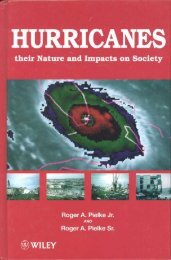How to evaluate vulnerability in changing environmental conditions
How to evaluate vulnerability in changing environmental conditions
How to evaluate vulnerability in changing environmental conditions
Create successful ePaper yourself
Turn your PDF publications into a flip-book with our unique Google optimized e-Paper software.
Predictability and Uncerta<strong>in</strong>ty<br />
Roger A. Pielke, Sr. .Gerhard Petschel-Held .Pavel Kabat. Brad Bass. Michael F. Hutch<strong>in</strong>son<br />
Vijay Gupta. Roger A. Pielke, Jr. .Mart<strong>in</strong> Claussen. Dennis Shoji Ojima<br />
It is appropriate <strong>to</strong> consider water quantity and water<br />
quality as two facets of water resources. Both facets are<br />
<strong>in</strong>timately connected <strong>to</strong> the hydrological cycle, which itself<br />
is a component of the Earth's climate system. S<strong>in</strong>ce<br />
human activities and health are so connected <strong>to</strong> water<br />
resources, it is essential <strong>to</strong> determ<strong>in</strong>e how far <strong>in</strong><strong>to</strong> the<br />
future we can predict the condition of the water resources<br />
of a region with a sufficient level of confidence. When<br />
predictions are not possible, resilience must be built <strong>in</strong><strong>to</strong><br />
a water system so that human (and natural) needs are<br />
not negatively affected. Even when skillful predictions<br />
are possible, they are seldom completely accurate. Thus<br />
uncerta<strong>in</strong>ty needs <strong>to</strong> be <strong>in</strong>cluded when scientific analyses<br />
and predictions are used for water resource plann<strong>in</strong>g<br />
and management, particularly for issues such as adaptation<br />
or risk management. The prediction of weather and<br />
climate are essential aspects of plann<strong>in</strong>g for water resources<br />
<strong>in</strong> chang<strong>in</strong>g <strong>environmental</strong> <strong>conditions</strong>.<br />
Lorenz (1979) proposed the concept of forced and free<br />
variations of weather and climate. He refers <strong>to</strong> forced<br />
variations as those caused by external <strong>conditions</strong>, such<br />
as changes <strong>in</strong> solar irradiance. Volcanic aerosols also<br />
cause forced variations. He refers <strong>to</strong> free variations as<br />
those which "are generally assumed <strong>to</strong> take place <strong>in</strong>dependently<br />
of any changes <strong>in</strong> external <strong>conditions</strong>". Day<strong>to</strong>-day<br />
weather variation is presented as an example of<br />
free variations. He also suggests that "free climatic variations<br />
<strong>in</strong> which the underly<strong>in</strong>g surface plays an essential<br />
role may therefore be physically possible".<br />
<strong>How</strong>ever, if the ocean surface and/or land-surface<br />
changes over the same time period as the atmosphere<br />
changes, then the non-l<strong>in</strong>ear feedbacks (i.e. two-way<br />
fluxes) between the air, land and water, elim<strong>in</strong>ate an <strong>in</strong>terpretation<br />
of the ocean-atmosphere and land-atmosphere<br />
<strong>in</strong>terfaces as boundaries. Rather than "boundaries",<br />
these <strong>in</strong>terfaces become <strong>in</strong>teractive media (Pielke 1998a,<br />
2001). The two-way fluxes that occur between the atmosphere<br />
and ocean, and the atmosphere and the land- surface<br />
(as detailed <strong>in</strong> Part A of this book), must therefore<br />
necessarily be considered as part of the predictive system.<br />
On the time scale of what we typically call shortterm<br />
weather prediction (days), important feedbacks<br />
<strong>in</strong>clude biophysical (e.g. vegetation controls on the Bowen~<br />
,<br />
ratio), snow cover, clouds (e.g. <strong>in</strong> their effect on the surface<br />
energy budget), and precipitation (e.g. which changes<br />
the soil moisture) processes. This time scale is already<br />
considered <strong>to</strong> be an <strong>in</strong>itial value problem (Sivillo et al.<br />
1997> s<strong>in</strong>ce operational numerical weather prediction<br />
models are rout<strong>in</strong>ely re<strong>in</strong>itialised twice daily. Seasonal<br />
and <strong>in</strong>terannual weather prediction <strong>in</strong>clude the follow<strong>in</strong>g<br />
feedbacks: biogeochemical (e.g. vegetation growth and<br />
senescence); anthropogenic and natural aerosols (e.g.<br />
through their effect on the long- and short -wave radiative<br />
fluxes and their effects on cloud microphysics and hence<br />
the hydrological cycle); sea ice; and ocean sea surface temperature<br />
(e.g. changes <strong>in</strong> upwell<strong>in</strong>g such as those associated<br />
with an El N<strong>in</strong>o) effects. For even longer time periods<br />
(of years <strong>to</strong> decades and longer), the additional feedbacks<br />
<strong>in</strong>clude biogeographical processes (e.g. changes <strong>in</strong><br />
vegetation species composition and distribution), anthropogenic-caused<br />
land-use changes, and deep ocean circulation<br />
effects on the ocean surface temperature and sal<strong>in</strong>ity.In<br />
the context of Lorenz's (1979) term<strong>in</strong>ology, each<br />
of these feedbacks are free variations.<br />
We beg<strong>in</strong> <strong>to</strong> tackle this problem by us<strong>in</strong>g a hierarchy<br />
of models. We will consider two examples <strong>to</strong> illustrate<br />
this important po<strong>in</strong>t. First example is the O-dimensional<br />
dynamical model (hav<strong>in</strong>g no spatial dimensions, i.e.<br />
o-th order <strong>in</strong> space) which fully and non-l<strong>in</strong>early couples<br />
radiation, biota, and the hydrological cycle, with<br />
other components of the Earth climate system. This step<br />
is necessary <strong>to</strong> obta<strong>in</strong> a fundamental theoretical understand<strong>in</strong>g<br />
of the first-order effects on planetary climate.<br />
These first-order effects tend <strong>to</strong> be associated with both<br />
positive and negative feedbacks. It seems particularly<br />
important <strong>to</strong> <strong>in</strong>clude negative feedbacks, or the "homeostatic"<br />
mechanisms <strong>in</strong> the language of Watson and Lovelock<br />
(1983), <strong>in</strong> low-dimensional dynamical models.<br />
Negative feedbacks tend <strong>to</strong> be underrepresented <strong>in</strong> more<br />
complex <strong>in</strong>f<strong>in</strong>ite dimensional dynamical models, <strong>in</strong>volv<strong>in</strong>g<br />
one or more spatial dimensions, and therefore are<br />
less well unders<strong>to</strong>od.<br />
Insight from simple non-l<strong>in</strong>ear dynamical models<br />
should serve as foundations for the development of more<br />
complex models (Shackelyet al. 1998; Ghil and Childress<br />
1987>. Negative feedbacks com<strong>in</strong>g from coupl<strong>in</strong>g with~














